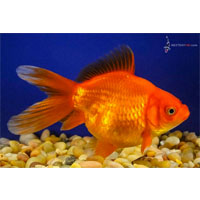Hailing from the Yamagata Prefecture in Northern Japan, the Sabao is a single caudal tailed fancy goldfish. The tail length can be both long and short. It comes down to personal preference.
Sabao are a cross between the single-tailed Syounia and the twin-tailed Ryukin. The single tail of the Syounia was inherited whereas the body conformation, though not as deep, is closer to that of a Ryukin. Sabao have been described looking like a “plump common goldfish.”
Pond Ready
The ability to weather colder water temperatures (inherited from the Syounai) makes this a strong candidate for outdoor pond life, where in most instances they can withstand winter temperatures. However, it is equally at home in a tank.
Size
They can grow in excess of 10” so the size of the tank used becomes a factor when an enthusiast is looking to add a Sabao to their collection.
A Breed Apart
Sabao are often mistaken for for their close relatives, Tamasaba, but there are some differences. Although both share similar body construction (both having single caudal and anal fins), the main distinguishing characteristic is the missing “hump” in the shoulder region. Tamasaba have a pronounced arch behind the head that stretches up the back to the dorsal fin. Sabao—taking more from the Syounai genealogy—do not possess the “hump” so the line from the head to the dorsal fin is smooth and more rounded.
Additionally, although quite deep, Sabao don’t share the fuller figure of the Tamasaba (which was inherited from the Ryukin), allowing them to get around a little more quickly. Despite their rounded body shape, Sabao are actually quite agile swimmers.
Coloration
 Unlike Tamasaba, Sabao only come in various shades of red and red and white.
Unlike Tamasaba, Sabao only come in various shades of red and red and white.
Passing Judgement
Sabao aren’t as well represented in the United States and as such are considered somewhat of a rarity in US ponds and aquariums. However, there are judging standards for the Sabao at shows that define excellence and preferred features.
This is the Standard of Evaluation used for both Sabao and Tamasaba.
Body shape
- Rounded, ball-like shape both from upper and side view.
- The risen shoulder (Tamasaba) and the abdomen from the lateral line (the line from the head to the tail, not the organ) are well balanced with the horizontal line from the head to the peduncle preferable.
- Shorter caudal peduncles are better.
- Vigorously and elegantly stretched tail fins that are both vibrant and lively.
Finnage
- Vigorous and healthily stretched dorsal fins.
- Individual fins exhibit no splitting or curving from injury.
- The gestures to show, with pectoral fins looking pretty .
- Disease- and/or injury-free fins.
Swimming postures
- Remains horizontal and is well balanced and elegant at a standstill.
- “Graceful but wild,” but equally pretty swimming style.
Pattern
- Interest-piquing, engaging, beautiful color pattern.
Color
- Vivid and deep red color.
- Pattern edges are sharp and vivid.
- Edges not straight ie the patterns aren’t composed of straight lines
- Clear or shiny white color.
- Gold/Orange even calico.
Exceptional Features
- Extra-large body
- Unique body shape, pattern, scales and color.

